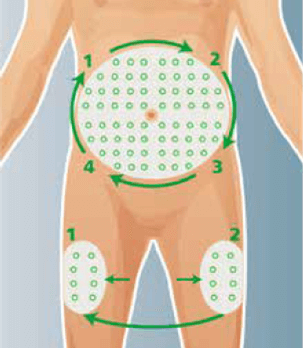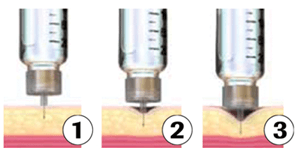Demystifying injections
Diabetes is often associated with injections—whether it’s for capillary blood glucose testing, insulin injections or other injectable medications. In fact, in recent years, it is not only insulin that can be injected, but also other diabetes medications.
Having to inject medication yourself can be unsettling for many people, but most people don't feel fear after a few times. Many people even breathe a sigh of relief after the first injection, because the injection is not as painful or complicated as they expected.
Insulin and other injectable medications come in a pen with a single-use needle attached to the end. Depending on the type of medication you are injecting, your healthcare provider will tell you when and how often to inject.
Your healthcare provider should also take the time to show you how to do the injections properly. Some key points to remember:
- It is recommended to use short 4 mm, 5 mm or 6 mm needles, regardless of the body mass index, to avoid intramuscular injection risk.
- It's important to rotate the injection sites properly. Repeatedly injecting in the same place can cause what is called lipohypertrophy: you feel bumps under the skin, or the skin feels rubbery. Insulin or medication injected into an area where lipohypertrophy is present may not work as intended because its absorption may be altered. To prevent this problem from occurring, it is important to regularly examine the sites where we inject to ensure that the skin is healthy.
Photo: lipohypertrophy areas around the navel

FIT Forum for Injection Technique Canada. Recommendations for Best Practice in Injection Technique. 4th Edition 2020. Available from: https://www._t4diabetes.com/_les/7816/0803/3133/FIT_Recommendations_2020.pdf
- The preferred injection sites are the abdomen, thighs and buttocks. The abdomen is the preferred area because it is easy to access, has a good surface area and a lower risk of intramuscular injection.
- To ensure a good injection site rotation, it is suggested to have a rotation plan: some people will decide to inject one week on the right side of the abdomen, then one week on the left side. Other people will have a more elaborate plan, as shown in the figure below. There is also a needle company that has four different colored caps, which can help you remember to change sites when you change colors.
Photo: possible rotation plan

FIT Forum for Injection Technique Canada. Recommendations for Best Practice in Injection Technique. 4th Edition 2020. Available from: https://www._t4diabetes.com/_les/7816/0803/3133/FIT_Recommendations_2020.pdf
- Do not press the pen too hard when injecting. Injectable medications (including insulin) must be injected into the layer of tissue just under the skin. If you press too hard, you risk injecting into the muscle, which can affect the action of the medication and make the injection painful.
Photo: Image 1: injection without excessive force, images 2-3: injection with excessive force

FIT Forum for Injection Technique Canada. Recommendations for Best Practice in Injection Technique. 4th Edition 2020. Available from: https://www._t4diabetes.com/_les/7816/0803/3133/FIT_Recommendations_2020.pdf
Rest assured, once you understand the procedure, most of the time the injections go very well. If you have any discomfort or questions, don't hesitate to discuss them with your healthcare professional (pharmacist, nurse, doctor).
Article written by:
Catherine Goulet Delorme, Diabetes Nurse Clinician, Certified Diabetes Educator at CIUSSS de l'Estrie - CHUS.
Get 24/7 diabetes support
Join the Accu-Chek engage® program and access many resources along with special offers
